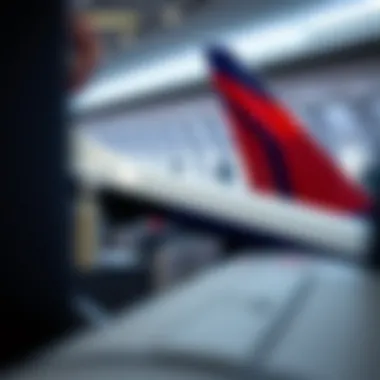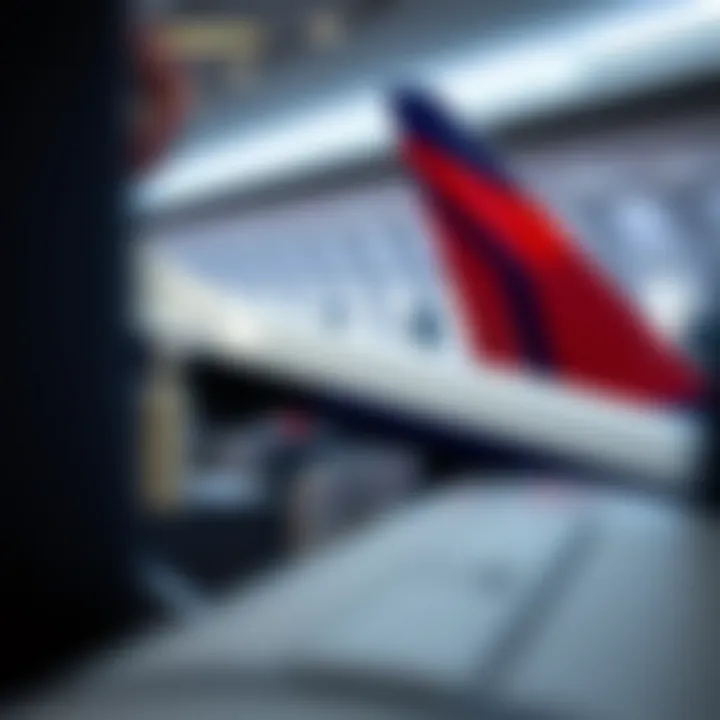Transferring Capital One Miles to Delta Airlines


Intro
The world of travel rewards can sometimes feel like a maze, especially when one is trying to figure out how to transfer Capital One miles to airlines like Delta. There’s a bit of a dance involved, and understanding the rhythm can lead to some very fruitful outcomes. This guide will shimmy through the important points surrounding these transfers.
By equipping yourself with knowledge about transfer ratios, the nitty-gritty of eligibility, and the bigger picture of redeeming rewards, you’ll be ready to take full advantage of what these programs have to offer. Whether you're just stepping into this realm or you've been hanging around the investment scene for a while, finding the best approach to use your Capital One miles can set you on the right path for optimizing your travel experience.
To begin, let’s break down some crucial terms often encountered in this arena which will be helpful while navigating the transfer landscape.
Understanding Capital One Miles
In navigating the realm of travel rewards, a solid grasp of Capital One miles is crucial. Understanding these miles not only illuminates how they function but also showcases their potential value when transferred to partner airlines like Delta. Capital One miles can serve as a currency of sorts—enabling you to book flights, accommodations, or even exclusive events. Comprehending how these miles work lays a foundation for optimizing your travel rewards and ensuring that you make the most of your investment.
Overview of Capital One Rewards System
The Capital One rewards system operates under a flexible model that allows cardholders to earn miles on every purchase. This can be particularly appealing for consumers looking to maximize their spending. Unlike some loyalty programs that restrict earnings to select categories, Capital One provides its users with a straightforward approach. You're essentially earning miles for expenditures they would already incur—be it dining out, filling up the gas tank, or making that big-ticket purchase.
But there’s more than just earning—Capital One miles can be redeemed in numerous ways. This includes travel bookings, shopping rewards, or even cashback options. The versatility of Capital One miles can cater to various preferences, making it an attractive system for new and seasoned travelers alike.
Earning Capital One Miles
Accumulating Capital One miles is rather uncomplicated. Users typically earn a set number of miles per dollar spent, which can range between 1.25 to 2 miles depending on the card type and spending category. For instance, if you have a Capital One Venture Rewards Credit Card, you’ll earn 2 miles for every dollar you spend on every purchase.
Here are some smart ways to enhance your miles collection:
- Use Your Card for Everyday Expenses: From grocery shopping to online subscriptions, using your card for regular purchases can make a significant difference in your miles balance.
- Sign-up Bonuses: Take advantage of sign-up bonuses offered by Capital One after meeting a minimum spending threshold within the first few months.
- Refer Friends or Family: Some cards offer miles for successful referrals, providing another avenue to increase your total.
Types of Capital One Miles
Capital One offers different types of miles, most notably Capital One miles and purchase rewards. This distinction is worthy of attention:
- Capital One Miles: These miles are more closely associated with travel rewards. When considering transfer options to airlines like Delta, understanding the value of these miles is imperative.
- Purchase Rewards: These can include cashback or other non-travel related rewards. They may not always align perfectly when transferring to an airline, but they could be redeemed for alternative travel expenses.
Understanding the different types of miles and how to earn them widens the horizon for capitalizing on your rewards strategy. Keeping an eye on the nuances can lead to opportunities that may otherwise slip through the cracks, allowing travelers to build a more comprehensive and effectively strategized rewards plan.
The Importance of Delta Airlines
Delta Airlines stands tall as one of the major players in the airline industry, making it a worthwhile consideration for many travelers. Its significance in the rewards transfer process is intricate and multi-faceted. For those looking to maximize their travel experience through benefits such as enhanced reward systems and better route networks, understanding what Delta brings to the table is key.
Delta SkyMiles Program Overview
Delta's SkyMiles program is designed to incentivize frequent fliers and enhance customer loyalty. Upon signing up, members can earn miles for every flight they take. It’s not a complex system; it just works. Miles earned can be redeemed for flights, upgrades, and even experiences. Plus, there are no blackout dates for reward travel, which grants members a level of flexibility that’s appealing on its own. Unlike some other airlines, Delta provides a straightforward tiered system in which members can achieve Silver, Gold, Platinum, and Diamond Medallion statuses, each offering increasingly attractive benefits like priority boarding and free checked bags. This tier system gives frequent travelers the chance to reap additional perks, making every mile count.
Benefits of Delta SkyMiles Membership
When you dive into the benefits of Delta SkyMiles membership, it’s easy to see why so many people choose to fly with this airline. Here are some of the standout perks:
- Earning Miles: Members can earn miles not just through flying but also by shopping with partner brands. Earn miles while you spend, it's like making money for things you already do.
- Usage Flexibility: With the wide array of redemption options, you’re not limited to just flights. From car rentals to hotel stays, your miles can be spent in various ways.
- Upgrading Experience: As a member, you can use your miles to upgrade your seating class, making that long flight a bit more bearable.
- Family Pooling: You can pool miles with family members to achieve those vacation goals quicker. This shared strategy can make the difference between a dream trip and just a pipe dream.
In a nutshell, the membership offers tangible value that extends far beyond just accumulating points, elevating your travel experience.
Delta’s Partnership Network


The landscape of airline partnerships shapes the travel ecosystem deeply. Delta Airlines boasts an extensive partnership network, enhancing the value of its SkyMiles program significantly. Collaborations with airlines such as Air France and KLM, among others, create a web of connection that allows fliers to reach various destinations across the globe with ease.
Imagine needing to travel somewhere and finding out you can use your SkyMiles on multiple airlines. The codeshare agreements ensure that travelers have smoother transitions and better options, which is a win-win situation. Plus, this network of partnerships opens the door to exclusive promotions and offers that can add even more value to your miles.
"In a world of constant connectivity, Delta's partnerships allow fliers to stretch their rewards further than ever, enabling access to enriched travel experiences."
Whether it’s hopping on a short flight or heading across the pond, Delta and its partners work together to maximize your travel flexibility. Choosing an airline like Delta not only simplifies the process of earning and redeeming miles but also enhances the essence of global traveling. This makes Delta Airlines not just an airline choice but a strategic ally in your travel journey.
Process of Transferring Miles
Transferring miles between rewards programs is like having a versatile toolkit; it opens doors to more travel possibilities and options. In particular, the process of transferring Capital One miles to Delta Airlines can benefit travelers immensely. Capital One has made significant strides in recent years, enhancing its partnership with airlines. This lends travelers the flexibility to utilize their hard-earned miles in different ways. Thus, understanding how to navigate the transfer process is key for optimizing your travel rewards efforts.
Initiating the Transfer
When you decide to move your Capital One miles to Delta, the first step is initiating the transfer. To kick off this process, log into your Capital One account. Navigate to the rewards section, where you’ll find an option to transfer miles. Make sure your Delta SkyMiles account is also in good standing and that you know your account number because you will need it.
Remember: Not every Capital One card allows for transfers to airlines. If you have a card that does, the process usually takes just a few clicks. But be aware that certain account types may have different terms.
After you enter the Delta account number and specify how many miles you wish to transfer, you’ll often need to confirm your choice. Double-check details like miles available and any bonuses that may apply, as these can influence your decision to transfer. Once everything looks good, hit the transfer button. After waiting a short while, those miles will land in your Delta account.
Timing and Limitations
Timing is crucial when you’re transferring miles. Some travelers might think that transferring miles is a walk in the park, but a few limitations often surprise users. Typically, the transfer process can take anywhere from a few minutes to a few days, depending on the systems involved.
Certain peak travel times or specific promotions might impact the time it takes for the miles to become available. Keep an eye on expiration dates too. If your Capital One miles are set to expire soon, it could push you to act faster than you’d prefer.
Additionally, there may be limits on how many miles you can transfer at once, or how frequently you may make transfers. Hence, it’s wise to check the terms associated with your specific Capital One card. Understanding these constraints can save you from future headaches or last-minute scrambles to use your miles effectively.
Transfer Ratios Explained
Transferring miles doesn’t always equate to a one-to-one exchange ratio. Generally speaking, for every two Capital One miles, you might receive one Delta SkyMiles. This is the crux of why transferring is an important decision; it can affect how you strategize your travel plans.
Although this 2:1 ratio can seem like a drawback, it’s vital to take a step back and analyze the bigger picture. For instance, if you’re eyeing a peak travel time or a flight with limited available seats, that might justify the transfer, even at a lesser ratio. Moreover, promotional transfer bonuses often pop up with various airlines, which can improve your miles' value.
To summarize, understanding the transfer ratios can empower you to make better decisions about whether to transfer or not. Weighing these ratios against your immediate travel needs will guide you toward optimizing each mile’s potential.
In essence, mastering the process of transferring Capital One miles to Delta Airlines means being well-informed and prepared. Keeping an eye on timing, constraints, and understanding the necessary ratios will pave the way for richer travel experiences.
Eligibility for Transfers
Understanding eligibility for transferring your Capital One miles to Delta Airlines is essential for anyone looking to get the most out of their rewards. The process is not just about the act of transferring miles but also involves adhering to specific account requirements and maintaining good standing with both Capital One and Delta. Failure to meet the necessary eligibility criteria can lead to missed opportunities or, worse, losing valuable miles.
Capital One Account Requirements
To initiate the transfer of miles, the first step is ensuring you have a Capital One account in good standing. This means that the account should be open and not subject to any restrictions or issues. Before you consider transferring, check the following:
- Account Type: Make sure you have a credit card from Capital One that earns miles. Not all Capital One cards have reward miles tied to them. Popular cards such as Capital One Venture Rewards or Capital One Spark Miles are great options that offer miles accumulation.
- Miles Balance: You need to have enough miles accumulated in your account. Capital One typically requires a minimum number of miles for transfer. It might not make sense to transfer if you lack sufficient mileage, as it could either trigger transfer fees or render the transfer insignificant.
- Account Age: Some users report that newer accounts may face restrictions on transferring miles shortly after opening. While there's no universal rule, being an established account holder could facilitate a smoother transfer process.
These requirements are not mere formalities. They ensure that the transfer process is secure and that the accounts involved are functioning appropriately. Thus, verifying your Capital One account status should be your first order of business.
Delta SkyMiles Account Standing


Once you’ve ensured your Capital One account is in tip-top shape, the next step is confirming that your Delta SkyMiles account is also active and in good standing. This is equally vital and deserves close attention:
- Active Membership: Your Delta SkyMiles account must be operational. If you’ve been inactive for an extended period, it might be beneficial to log in and make sure there are no holds or deactivation notices.
- Account Balance: Similar to your Capital One account, check that you don’t have any outstanding negative balance issues. While Delta doesn’t typically penalize accounts in the same way, it’s still best practice to keep your account healthy.
- Eligibility for Transfers: Typically, Delta has no major restrictions on receiving miles, but ensuring your account meets all guidelines is crucial. Any irregularities may cause your transfer request to be denied or delayed.
If there are any potential issues such as past mile expirations or unresolved customer service claims, resolving them beforehand can save you a lot of headaches down the line. No one wants to find their miles stuck in limbo because of an unnoticed account issue.
"Keeping an eye on both your Capital One and Delta accounts is like having two birds in hand—they're not just miles, but opportunities to travel and explore."
In summary, knowing the eligibility requirements for transferring Capital One miles to Delta is a necessary step in maximizing your travel rewards. Focus on maintaining good standing in both accounts, and you’ll find the transfer process to be a seamless one.
Maximizing Miles Value
Maximizing the value of your miles is a crucial aspect of optimizing your travel rewards strategy. With both Capital One miles and Delta SkyMiles at your disposal, it becomes essential to navigate the complexity of how to get the most bang for your buck. Knowing the ins and outs of these rewards can substantially elevate your travel experiences, allowing you to fly further or in more comfort than you might initially anticipate.
The ability to transfer Capital One miles to Delta can unlock a treasure trove of opportunities, particularly for those who frequently fly with this airline. This section dives into the details of understanding value in miles and presents strategies for redeeming them in the most effective manner.
Understanding Miles Value
To grasp the essence of miles value, it helps to think of your miles as a form of currency, where each mile signifies a specific worth—this value can fluctuate based on various factors including your chosen flight, destination, and time of travel. Most airline miles, including Delta's SkyMiles, don’t have a fixed value. Rather, that worth is context-dependent, shaped by supply and demand along with the routes’ popularity.
Generally speaking, travelers can expect Delta SkyMiles to average between $0.01 and $0.015 per mile. However, savvy mileage experts often find ways to leverage their miles to achieve a value exceeding this average. Choosing flights during off-peak seasons, opting for round-trip bookings, or taking advantage of promotional offers can significantly skew your earning potential in your favor.
"Understanding the value of your miles can mean the difference between a mediocre flight experience and a first-class getaway."
Optimizing Redemption Options
Delving into redemption options is where the fun begins. Think of your Capital One miles like ingredients in a recipe; how they’re combined determines the outcome. While transferring directly to Delta can be rewarding, other paths might lead you to more value.
- Award Flights: These are often the crown jewel of mileage redemptions. When booking, look for routes that may be less traveled or less popular. For instance, finding a direct flight from a regional hub instead of a major metropolitan airport can yield significant savings.
- Upgrades: If you’ve got a long haul flight in your sights, considering using your miles for an upgrade to business class can provide a luxurious boost to your journey, making it a worthwhile investment.
- Combining Miles: Don’t forget the chance of using your Capital One miles in conjunction with promotions or partner offers. Collaborating with hotels or car rental services can stretch your ability to maximize rewards on every front.
Each of these options requires foresight and a bit of strategic planning. With a keen understanding of both the miles you hold and how they can be utilized, you can transform potential into reality, allowing for incredible travel experiences that might seem unattainable otherwise.
Ending
Maximizing your miles value is not just about accumulating them; it’s about making informed choices that lead to rewarding experiences. Whether through strategic transfers, utilizing upgrades, or exploring various redemption options, the knowledge and application of these tactics will ensure your Capital One miles journey is not only fruitful but also remarkably fulfilling.
Alternative Reward Options
When considering travel rewards, it's essential to weigh your options. While transferring Capital One miles to Delta Airlines offers a solid avenue for travelers to maximize their mileage, there exist alternative reward options that can also prove beneficial. Understanding these alternatives not only empowers you to make informed decisions but can also enhance your travel experiences and offer unexpected savings.
Redeeming for Cashback
One of the most straightforward methods for utilizing your Capital One miles is through cashback redemption. This option allows cardholders to convert miles into cash credits that can offset any recent purchases. The flexibility here is immense; you can use this cashback in various ways, from reducing monthly bills to funding spontaneous vacations. Moreover, it's particularly advantageous for those who may not frequently fly or have specific travel plans.
For instance, if you have a strong desire to save up for that dream trip but also face a looming credit card bill, using your Capital One miles for cashback might just be the ticket.
"Sometimes, having that cash in hand for unexpected expenses is more valuable than sitting on miles you may not use quickly."
In this sense, redeeming miles for cashback is not just about immediate utility; it serves as a strategic financial move.
Booking Travel Directly


Booking travel directly is another compelling alternative. With Capital One's travel portal, users can transform their miles into direct bookings for flights, hotels, and more. The process tends to be seamless—search for your desired flight or accommodation, select your preferences, and see how your miles can help you save on costs.
- Convenience: This option offers ease of use. Access the travel portal via the Capital One website or app, and you’ll find a streamlined interface designed for a pleasant user experience.
- Potentially Better Deals: Sometimes, utilizing miles for direct bookings can yield lower prices compared to transferring to airlines. While the best value tends to be found through strategic airline partnerships, it's worth exploring your options as prices fluctuate.
- Flexible Accommodations: Beyond flights, using miles for hotel stays or rental cars can add another layer of convenience to your travel planning.
It’s critical to compare ticket prices on the open market against the miles cost to ensure you are making the best financial choice. Understanding how to navigate both realms—cashback and direct travel bookings—allows you to engineer a reward strategy that fits your lifestyle.
Common Challenges and Solutions
Navigating the world of travel rewards, particularly when transferring Capital One miles to Delta Airlines, can present a fair share of hurdles. Addressing common challenges is crucial for ensuring that travelers can fully benefit from their hard-earned miles. Understanding these issues not only raises awareness among travelers but also enhances their overall experience. Having a strategy to overcome these challenges allows individuals to make the most of their rewards and travel opportunities.
Transfer Delays
Transfer delays are a common issue that travelers encounter when moving their Capital One miles to Delta. These delays can be frustrating, especially when you have an imminent trip planned and want to utilize your miles for ticket booking.
It typically takes some time for the transferred miles to reach your Delta account. While the process can be instantaneous for some, expect it to take up to 48 hours for others. Here are some tips to help mitigate issues:
- Plan Ahead: If you're aware that you need to transfer miles, do so well in advance. Waiting until the last minute can lead to disappointment.
- Check Transfer Limits: Each account may have its own transfer limits. Understanding these can prevent potential surprises.
- Contact Customer Service: If you're facing a delay, don't hesitate to reach out to Capital One's customer support or Delta's customer service for assistance.
"It's better to have a plan in mind and adjust it than to scramble when time is tight."
This approach can help travelers manage their expectations and allows them to stay informed throughout the transfer process.
Miles Expiration Concerns
Another aspect that often weighs heavily on travelers' minds is the fear of miles expiration. Both Capital One miles and Delta SkyMiles can have specific expiration rules that users should be mindful of. Capital One miles typically remain valid as long as your account stays active, but Delta's SkyMiles can expire if there is no activity for 24 months.
To avoid losing valuable miles:
- Stay Active: Periodically use your SkyMiles, whether through booking flights or making small purchases.
- Monitor Your Accounts: Keep an eye on your account balance and expiration statuses. Most airlines provide notifications as expiration dates approach.
- Consider Extending Miles: Some credit cards offer options to extend the validity period of your miles for a fee, so look into your Capital One card features.
- Enroll in Delta's SkyMiles Program: Becoming a member can sometimes provide additional protections or bonuses against mile expiration.
Addressing these concerns proactively ensures that travelers can not only transfer their miles successfully but also retain them for future adventures without the worry of expiration.
In summary, understanding and managing potential transfer delays and expiration concerns strengthens your position within the miles game. By staying informed and taking deliberate actions, investors in travel rewards can navigate challenges with confidence.
Future of Airline Reward Programs
The landscape of airline reward programs is evolving rapidly, and understanding this evolution is essential for savvy travelers. With numerous airlines vying for customer loyalty, the future of travel rewards will likely be shaped by shifting consumer preferences, technological advancements, and strategic partnerships. As travelers, knowing what to anticipate can influence decisions on how to earn and redeem miles differently in the years to come.
Trends in Miles Transferability
One of the most significant trends in the realm of airline rewards is the increasing fluidity of miles transferability across different loyalty programs. This aspect has gained traction as airlines seek to attract a more diverse customer base. No longer are travelers confined to using miles solely within the program they accrued them; instead, they can now transfer them into partner airlines, enhancing their travel options considerably.
A few key points underlining this trend include:
- Alliances and Codeshare Agreements: More airline partnerships through alliances such as SkyTeam, Star Alliance, and Oneworld offer shared benefits and easier transfers. This means you can more easily move your miles around.
- Rewards Optimization: Travelers are no longer just focusing on one airline’s rewards program but are considering how to maximize the value of their miles through strategic transfers, increasing competition among airlines.
- User-Friendly Platforms: Various airlines have made strides in creating intuitive platforms for transferring miles. These are aimed at both novice travelers and seasoned pros, ensuring an easier experience overall.
With these trends, travelers might find that sticking strictly to one airline becomes less appealing. The versatility of miles transferability adds layers of value to loyalty programs, presenting abundant opportunities for consumers.
The Impact of Market Changes
Market fluctuations significantly influence how airline reward programs operate. Factors ranging from economic downturns to advancements in technology can reshape how airlines structure their loyalty initiatives.
Here are a few insights regarding market changes:
- Economic Conditions: In times of economic prosperity, airlines may enhance rewards and benefit programs to lure more customers. Conversely, during downturns, they might tighten eligibility or reduce rewards to control costs.
- Technological Innovations: Airlines are increasingly adopting tech solutions that allow for real-time analysis of consumer behavior. This trend enables them to adjust their reward offerings swiftly in response to market changes, ensuring they stay competitive.
- Customer Demand for Flexibility: The current demand for flexibility, particularly observed during crises like the COVID-19 pandemic, has led airlines to re-evaluate cancellation policies and refund processes, which in turn affects their loyalty programs.
"Adaptability is the name of the game for airlines seeking to build robust reward programs that resonate with today's travelers."



